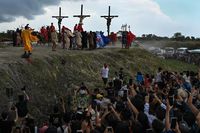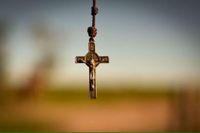As Holy Week unfolds, millions across the United States and Latin America prepare to observe significant religious events, including Holy Thursday on April 17, Good Friday on April 18, and Easter Sunday on April 20, 2025. This period is not just a time of reflection but also a celebration of family and community traditions.
Holy Thursday, known as Jueves Santo, commemorates the Last Supper of Jesus and his disciples. It is a day that encourages acts of solidarity and community service. Many parishes in cities with large Latino populations, such as Miami, Los Angeles, and New York, organize special masses and foot-washing ceremonies. According to USA TODAY, these rituals prompt congregants to reflect on their service to others.
In addition to foot washing, the traditional practice of visiting seven churches, which is common in countries like Mexico, El Salvador, and Colombia, is also replicated in Hispanic communities throughout the U.S. Many faithful take this opportunity to pray, confess, and engage in social initiatives.
Good Friday, observed on April 18, is a day of solemnity and reflection, dedicated to the Passion of Christ. While it is not a public holiday in the U.S., many individuals take the day off to participate in religious activities. Parishes celebrate live Via Crucis processions and outdoor services that focus on the passion and death of Jesus. This day is marked by fasting and abstaining from meat, with many Latin dioceses organizing community events in public squares that blend prayer, art, and religious culture.
Fasting, a practice rooted in self-discipline, holds particular significance during Holy Week. The Catholic Church instructs the faithful to fast on Ash Wednesday and Good Friday, allowing only one full meal and two smaller portions that together do not exceed a regular meal's amount. Abstinence from meat is also required on these days, along with all Fridays during Lent, as a sign of penitence and spiritual reflection.
As Holy Week culminates, Easter Sunday, celebrated on April 20, marks the resurrection of Jesus. This joyous occasion is filled with hope and renewal. Many Latino families in the U.S. blend religious traditions with local customs, such as Easter egg hunts and traditional meals featuring sweet bread, tamales, or empanadas. Masses on this day center on the resurrection of Jesus, emphasizing messages of unity and hope.
Social media plays a significant role in these celebrations, with Christian communities using hashtags like #Pascua2025 and #DomingoDeResurrección to share reflections, photos, and messages of faith. Beyond its religious significance, Holy Week provides a much-needed pause from the chaos of daily life, allowing individuals to reconnect with their faith, family, and values like compassion and forgiveness amid a socially divided context.
Across the globe, Holy Thursday is observed with diverse traditions reflecting cultural and religious significance. In Spain, cities like Seville, Malaga, and Valladolid host grand processions where brotherhoods carry representations of the Passion of Christ, accompanied by music and solemnity. The washing of feet ceremony, symbolizing Jesus' humility, is a common practice in many churches.
In Italy, the Pope traditionally celebrates the Mass of the Lord's Supper in St. Peter's Basilica. However, due to a recent hospitalization for pneumonia, Pope Francis only attended a foot-washing ceremony at Regina Coeli Prison in Rome, where he engaged with approximately 70 inmates of various nationalities. This event underscores the Pope's commitment to embodying the humility and service exemplified by Jesus.
In the Philippines, a country with a significant Catholic population, Holy Thursday is marked by dramatic displays of faith. Penitents walk barefoot through the streets, whipping themselves as a form of penance, while others participate in crucifixion reenactments, reflecting the depth of their devotion.
Holy Thursday not only represents the institution of the Eucharist but also serves as a poignant reminder of Jesus' final moments with his disciples. During the Last Supper, Jesus broke bread and shared wine, instituting one of the fundamental sacraments of Christianity. He famously stated, “Take and eat; this is my body,” and “Drink from it, all of you; this is my blood of the covenant, which is poured out for many for the forgiveness of sins.” These words, found in the Gospels, resonate deeply with believers as they commemorate this sacred event.
As the Holy Week progresses, it culminates in the celebration of Easter Sunday, which is not only a day of religious significance but also a time for family reunions and cultural festivities. The joy of the resurrection is celebrated with various customs, including egg hunts and festive meals that bring families together.
Ultimately, Holy Week serves as a reminder of the core tenets of Christianity—sacrifice, redemption, and the promise of new life. It invites individuals to reflect on their faith and the values that unite them, fostering a sense of community and shared purpose.
As the faithful prepare to observe these significant days, they carry with them the hope and message of resurrection, ready to embrace the renewal that Easter brings.








